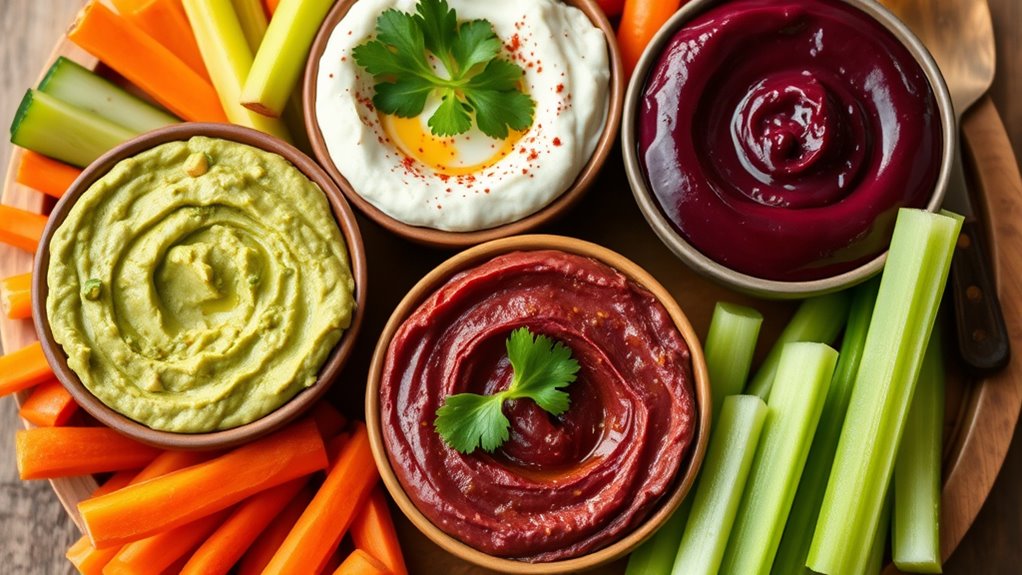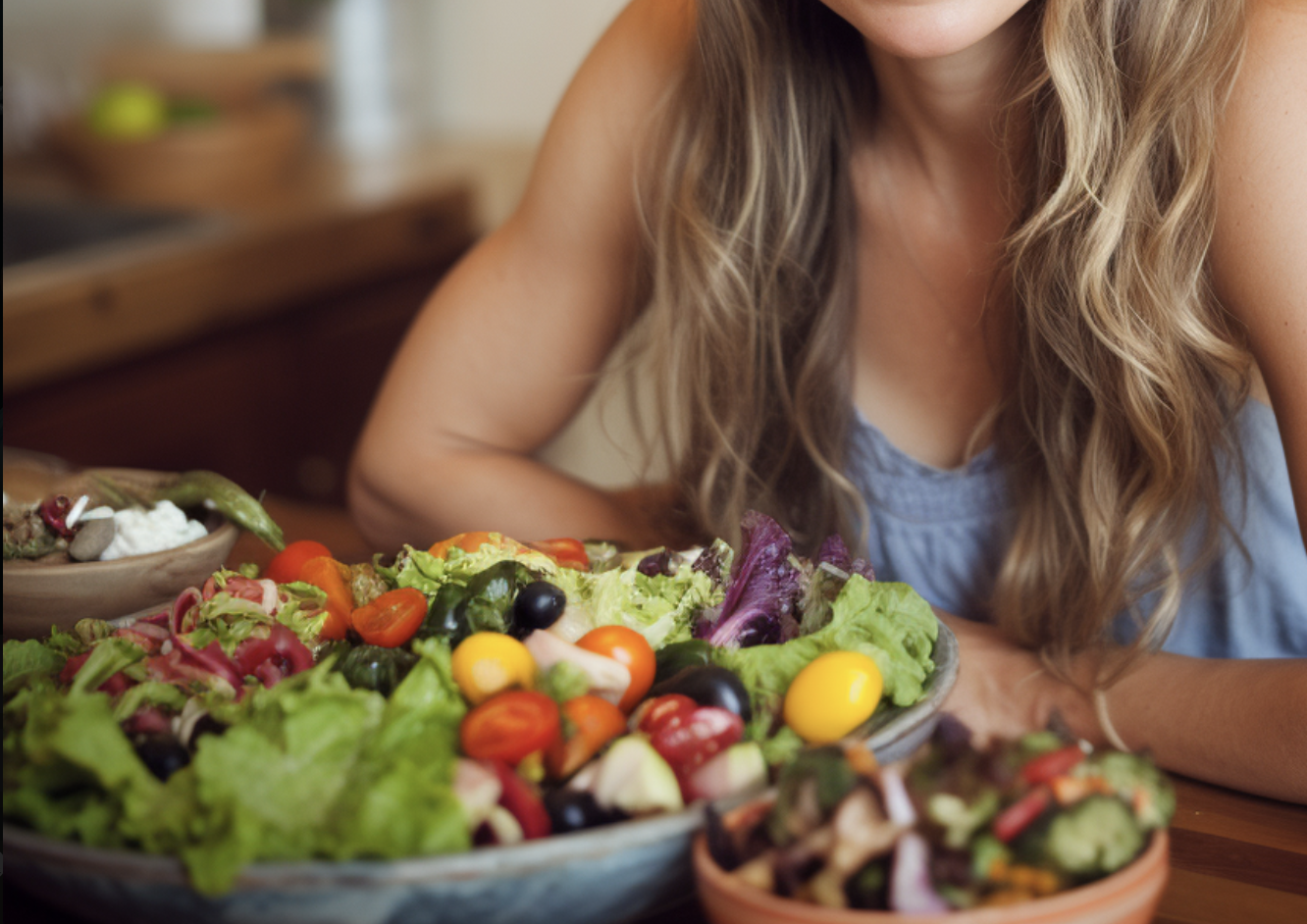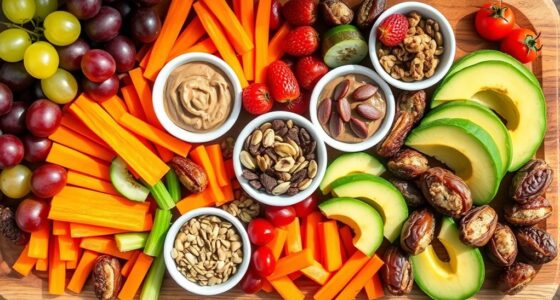Elevate your veggie platters with five vibrant, raw dips and spreads that are both colorful and delicious. Try classics like creamy hummus, spicy guacamole, or inventive options like beetroot and avocado dips. Use fresh herbs, layered textures, and appealing garnishes to make each presentation visually stunning. Experiment with ingredient swaps to customize flavors and boost nutritional value. Keep exploring for even more ideas to turn simple veggies into gourmet bites that will impress every guest.
Key Takeaways
- Highlight a variety of colorful, raw dips like hummus, guacamole, beetroot dip, and spicy avocado spread for visual appeal.
- Incorporate creative presentation techniques such as arranging dips in small bowls with garnishes and layered bases.
- Suggest ingredient substitutions to customize flavors and cater to dietary preferences, enhancing both taste and nutritional value.
- Encourage experimentation with textures and ingredients, like adding diced vegetables or herbs, to elevate dip complexity.
- Emphasize combining artistic styling with flavor variety to create eye-catching, delicious veggie platter spreads.

Raw dips and spreads are a fresh and versatile way to elevate your snacking game. When you serve them on your veggie platters, you instantly add color, flavor, and a touch of creativity that impresses everyone. To make your presentation stand out, focus on artistic presentation techniques. Use small bowls or ramekins for each dip, arranging them in a visually appealing pattern. Incorporate garnishes like chopped herbs, thinly sliced vegetables, or edible flowers to add pops of color and texture. The goal is to turn your platter into a feast for the eyes as well as the palate. Play with different shapes and heights—use small leaves of lettuce or cucumber slices as bases for dips to create layers and depth. These touches transform simple spreads into eye-catching art pieces that invite curiosity and excitement at the table.
When making raw dips and spreads, ingredient substitutions are a game-changer. You don’t have to stick rigidly to traditional recipes; instead, tailor each dip to your tastes or what’s available in your kitchen. For instance, if a recipe calls for tahini but you don’t have any, peanut butter or sunflower seed butter can work perfectly. Want to make a vegan-friendly version? Swap out dairy ingredients for plant-based alternatives like coconut yogurt or cashew cream. If you’re aiming for a more vibrant color or flavor, add roasted red pepper, turmeric, or fresh herbs. These substitutions don’t just keep your dips interesting—they allow you to customize them to your dietary needs and flavor preferences without sacrificing taste or texture.
Ingredient substitutions unlock endless flavor and dietary options for your raw dips and spreads.
Using ingredient substitutions also encourages experimentation, which keeps your snack options fresh and exciting. Instead of a traditional guacamole, try blending avocado with spicy sriracha, lime juice, and chopped cilantro, then top with diced tomatoes and red onion. For a hummus variation, swap chickpeas for roasted cauliflower or beetroot for a stunning pink hue and earthy flavor. When you’re plating, think about how each variation pairs with your vegetable selection. Bright, creamy, or spicy spreads can transform simple veggie sticks into a gourmet experience. Incorporating rustic decor elements can also enhance the visual appeal of your platter, tying it back to farmhouse-inspired aesthetics. Plus, these substitutions often boost nutritional value, giving your platter a healthy edge.
In essence, the art of creating raw dips and spreads lies in your presentation and your willingness to adapt and experiment. By focusing on artistic presentation, you’ll make your veggie platter more enticing. Embracing ingredient substitutions opens up endless possibilities, ensuring your snacking never gets boring. With a bit of creativity, your raw dips and spreads will not only taste delicious but also look stunning, making your snack time truly special.
Frequently Asked Questions
How Long Can Raw Dips Be Stored Safely?
You wonder how long raw dips can be stored safely. Typically, the storage duration is about 3 to 4 days in the refrigerator. To keep them fresh, follow proper refrigeration tips, like storing in airtight containers and keeping the temperature below 40°F. Always check for signs of spoilage, such as sour smell or mold, before consuming. Proper storage helps guarantee your dips stay safe and tasty longer.
Are Raw Dips Suitable for People With Food Allergies?
Ever wonder if raw dips are safe for everyone? You might think they’re universally suitable, but beware—nut allergy considerations are vital. Some raw dips contain nuts or gluten, making them unsafe for allergy sufferers. Always check labels or recipes for gluten free options and allergen info. If you or your guests have food allergies, you’ll want to choose or prepare raw dips carefully to keep everyone safe and satisfied.
Can Raw Dips Be Prepared in Advance?
You can prepare raw dips in advance, but proper dip storage is key to maintaining freshness. To preserve their flavor and texture, store dips in airtight containers in the refrigerator. Be sure to cover them tightly and consume within a couple of days to guarantee maximum freshness. This way, your dips stay delicious and safe to enjoy when you’re ready to serve, making your veggie platter prep easier and more stress-free.
What Are Some Vegan-Friendly Raw Dip Options?
You’ll love exploring vegan-friendly raw dip options that offer great nutritional benefits and exciting flavor combinations. Think creamy avocado hummus, spicy walnut dip, or zesty tomato salsa. These dips are packed with healthy fats, fiber, and vitamins, making them both nutritious and delicious. Prepare them in advance to save time, and enjoy the vibrant flavors and health perks they bring to your veggie platter.
How Do I Prevent Raw Dips From Browning?
To prevent raw dips from browning, you should focus on oxidation prevention by adding a thin layer of plastic wrap directly on the dip’s surface, pressing out air. Using fresh ingredients also helps maintain color and texture. Keep the dip refrigerated until serving, and consider adding a splash of lemon juice or vinegar, which slows oxidation and keeps your dip vibrant and appetizing longer.
Conclusion
Now that you’ve explored these vibrant raw dips and spreads, think of them as the colorful palette of your veggie platter. Each dip is a brushstroke, adding flavor and personality to your healthy masterpiece. As you dip into these options, you’re not just nourishing your body, but also painting a picture of freshness and creativity. Let your platter be a canvas—a celebration of nature’s simplest, most beautiful ingredients. Enjoy the colorful journey!









